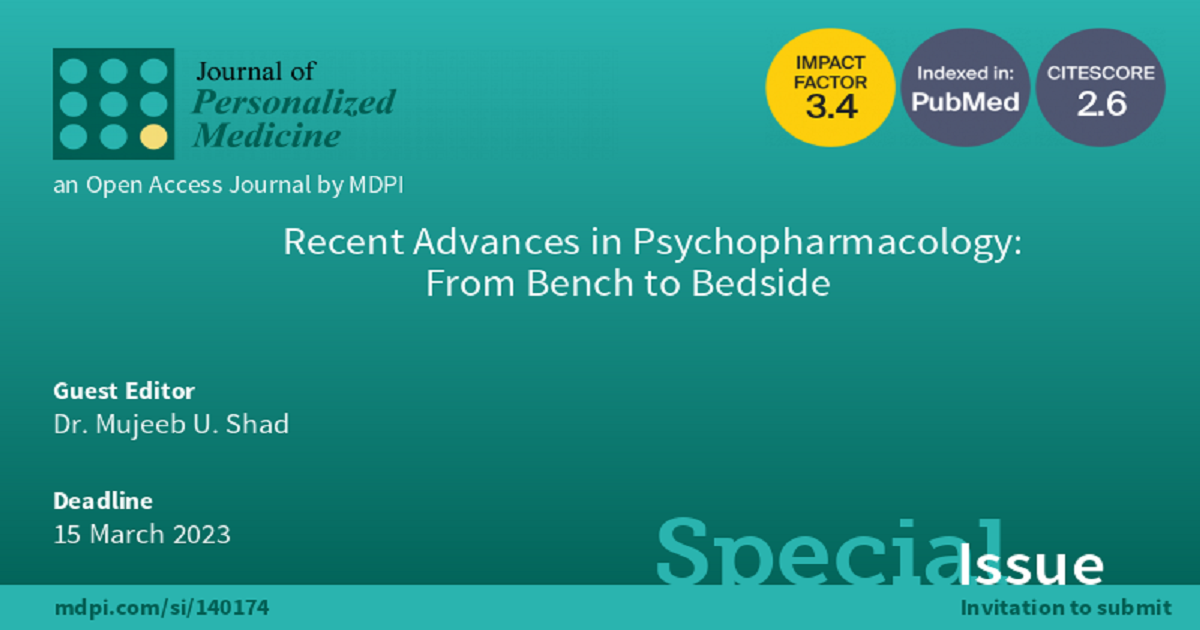Recent Advances in Psychopharmacology: From Bench to Bedside
A special issue of Journal of Personalized Medicine (ISSN 2075-4426). This special issue belongs to the section "Pharmacogenetics".
Deadline for manuscript submissions: closed (10 August 2024) | Viewed by 11978

Special Issue Editor
2. Department of Psychiatry, University of Nevada, Las Vegas, NV 89154, USA
3. College of Osteopathic Medicine, Touro University Nevada, Las Vegas, NV 89014, USA
Interests: psychopharmacology; pharmacogenomics; functional and structural neuroimaging; cognition
Special Issue Information
Dear Colleagues,
Historically, the mid-1950s were the most revolutionary time in psychopharmacology, when the first effective psychotropic medications were discovered for major depressive disorder and schizophrenia. Over the last several decades, our focus remained on developing "me too" drugs, primarily involving monoamine systems. However, after realizing that there might be greener pastures beyond monoamines, the paradigm has now shifted from monoamine to glutamatergic and GABAergic mechanisms, the core excitatory and inhibitory neurotransmitter systems, respectively. Although it took us a long time, one of the most exciting and recent discoveries has been the rapid onset of antidepressant efficacy with ketamine, which blocks one of the ionotropic glutamate receptors, N-Methyl-D aspartate (NMDA), instead of modulating the monoamine system. Since ketamine is often labeled as a psychedelic, its approval opened up significant research with more classical psychedelics, such as psilocybin, which also appears to have relatively rapid onset of antidepressant effects. Another novel breakthrough was the discovery of an allosteric modulator of GABA-A receptors, brexanolone, the first medication approved to manage post-partum depression. A significant level of promising research is also occurring in schizophrenia, such as glycine transporter-1 (Glyt-1) inhibition, and transient amine-associated receptor-1 (TAAR-1) agonism, as the novel mechanisms to address negative and cognitive symptom domains that are not generally responsive to the dopamine and serotonin–dopamine antagonists. Furthermore, vesicular monoamine transporter-2 (VMAT-2) inhibitors valbenazine and deutetrabenazine have also offered the first effective treatment for tardive dyskinesia in schizophrenia patients. Other novel molecules being investigated for various psychiatric disorders also look promising. Although pharmacogenomic research in psychiatry is not advanced enough to provide a genetic basis for screening and developing new molecules, it offers significant promise for future studies. Based on this background, we launched this Special Issue as a platform to publish studies from researchers employing various research methods and technologies to study psychopharmacological advances in psychiatry. We welcome original papers, reviews, or meta-analyses based on animal and human studies. We will consider papers reporting observational, clinical trials, genetics, imaging, computational, health service research, and ecological and in vitro data.
Dr. Mujeeb U. Shad
Guest Editor
Manuscript Submission Information
Manuscripts should be submitted online at www.mdpi.com by registering and logging in to this website. Once you are registered, click here to go to the submission form. Manuscripts can be submitted until the deadline. All submissions that pass pre-check are peer-reviewed. Accepted papers will be published continuously in the journal (as soon as accepted) and will be listed together on the special issue website. Research articles, review articles as well as short communications are invited. For planned papers, a title and short abstract (about 250 words) can be sent to the Editorial Office for assessment.
Submitted manuscripts should not have been published previously, nor be under consideration for publication elsewhere (except conference proceedings papers). All manuscripts are thoroughly refereed through a single-blind peer-review process. A guide for authors and other relevant information for submission of manuscripts is available on the Instructions for Authors page. Journal of Personalized Medicine is an international peer-reviewed open access monthly journal published by MDPI.
Please visit the Instructions for Authors page before submitting a manuscript. The Article Processing Charge (APC) for publication in this open access journal is 2600 CHF (Swiss Francs). Submitted papers should be well formatted and use good English. Authors may use MDPI's English editing service prior to publication or during author revisions.
Keywords
- psychopharmacology
- bench to bedside
- personalized medicine
- pharmacogenomics
- pharmacogenetics
- molecular targets
- glutamate
- GABA
- psychedelics
Benefits of Publishing in a Special Issue
- Ease of navigation: Grouping papers by topic helps scholars navigate broad scope journals more efficiently.
- Greater discoverability: Special Issues support the reach and impact of scientific research. Articles in Special Issues are more discoverable and cited more frequently.
- Expansion of research network: Special Issues facilitate connections among authors, fostering scientific collaborations.
- External promotion: Articles in Special Issues are often promoted through the journal's social media, increasing their visibility.
- Reprint: MDPI Books provides the opportunity to republish successful Special Issues in book format, both online and in print.
Further information on MDPI's Special Issue policies can be found here.





